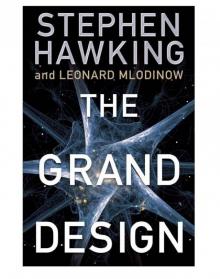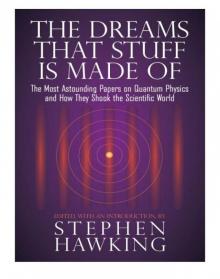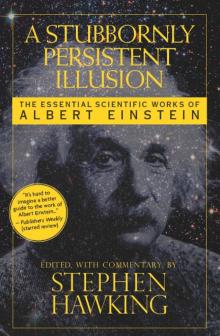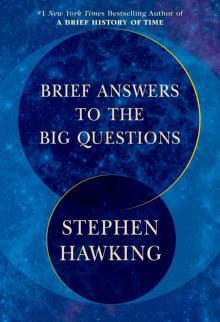- Home
- Stephen Hawking
Brief Answers to the Big Questions Page 8
Brief Answers to the Big Questions Read online
Page 8
To understand them, we need to start with gravity. Gravity is described by Einstein’s general theory of relativity, which is a theory of space and time as well as gravity. The behaviour of space and time is governed by a set of equations called the Einstein equations which Einstein put forward in 1915. Although gravity is by far the weakest of the known forces of nature, it has two crucial advantages over other forces. First, it acts over a long range. The Earth is held in orbit by the Sun, ninety-three million miles away, and the Sun is held in orbit around the centre of the galaxy, about 10,000 light years away. The second advantage is that gravity is always attractive, unlike electric forces which can be either attractive or repulsive. These two features mean that for a sufficiently large star the gravitational attraction between particles can dominate over all other forces and lead to gravitational collapse. Despite these facts, the scientific community was slow to realise that massive stars could collapse in on themselves under their own gravity and to figure out how the object left behind would behave. Albert Einstein even wrote a paper in 1939 claiming that stars could not collapse under gravity, because matter could not be compressed beyond a certain point. Many scientists shared Einstein’s gut feeling. The principal exception was the American scientist John Wheeler, who in many ways is the hero of the black hole story. In his work in the 1950s and 1960s, he emphasised that many stars would eventually collapse, and explored the problems this posed for theoretical physics. He also foresaw many of the properties of the objects which collapsed stars become—that is, black holes.
During most of the life of a normal star, over many billions of years, it will support itself against its own gravity by thermal pressure caused by nuclear processes which convert hydrogen into helium. Eventually, however, the star will exhaust its nuclear fuel. The star will contract. In some cases, it may be able to support itself as a white dwarf star, the dense remnants of a stellar core. However, Subrahmanyan Chandrasekhar showed in 1930 that the maximum mass of a white dwarf star is about 1.4 times that of the Sun. A similar maximum mass was calculated by the Russian physicist Lev Landau for a star made entirely of neutrons.
What would be the fate of those countless stars with a greater mass than the maximum mass of a white dwarf or neutron star once they had exhausted nuclear fuel? The problem was investigated by Robert Oppenheimer of later atom bomb fame. In a couple of papers in 1939, with George Volkoff and Hartland Snyder, he showed that such a star could not be supported by pressure. And that if one neglected pressure, a uniform spherically systematic symmetric star would contract to a single point of infinite density. Such a point is called a singularity. All our theories of space are formulated on the assumption that space–time is smooth and nearly flat, so they break down at the singularity, where the curvature of space–time is infinite. In fact, it marks the end of space and time itself. That is what Einstein found so objectionable.
Then the Second World War intervened. Most scientists, including Robert Oppenheimer, switched their attention to nuclear physics, and the issue of gravitational collapse was largely forgotten. Interest in the subject revived with the discovery of distant objects called quasars. The first quasar, 3C273, was found in 1963. Many other quasars were soon discovered. They were bright despite being at great distances from the Earth. Nuclear processes could not account for their energy output, because they release only a small fraction of their rest mass as pure energy. The only alternative was gravitational energy released by gravitational collapse.
Gravitational collapse of stars was rediscovered. When this happens, the gravity of the object draws all its surrounding matter inwards. It was clear that a uniform spherical star would contract to a point of infinite density, a singularity. But what would happen if the star isn’t uniform and spherical? Could this unequal distribution of the star’s matter cause a non-uniform collapse and avoid a singularity? In a remarkable paper in 1965, Roger Penrose showed there would still be a singularity, using only the fact that gravity is attractive.
The Einstein equations can’t be defined at a singularity. This means that at this point of infinite density one can’t predict the future. This implies that something strange could happen whenever a star collapsed. We wouldn’t be affected by the breakdown of prediction if the singularities are not naked—that is, they are not shielded from the outside. Penrose proposed the cosmic censorship conjecture: all singularities formed by the collapse of stars or other bodies are hidden from view inside black holes. A black hole is a region where gravity is so strong that light cannot escape. The cosmic censorship conjecture is almost certainly true, because a number of attempts to disprove it have failed.
When John Wheeler introduced the term “black hole” in 1967, it replaced the earlier name of “frozen star.” Wheeler’s coinage emphasised that the remnants of collapsed stars are of interest in their own right, independently of how they were formed. The new name caught on quickly.
From the outside, you can’t tell what is inside a black hole. Whatever you throw in, or however it is formed, black holes look the same. John Wheeler is known for expressing this principle as “A black hole has no hair.”
A black hole has a boundary called the event horizon. It is where gravity is just strong enough to drag light back and prevent it from escaping. Because nothing can travel faster than light, everything else will get dragged back also. Falling through the event horizon is a bit like going over Niagara Falls in a canoe. If you are above the Falls, you can get away if you paddle fast enough, but once you are over the edge you are lost. There’s no way back. As you get nearer the Falls, the current gets faster. This means it pulls harder on the front of the canoe than the back. There’s a danger that the canoe will be pulled apart. It is the same with black holes. If you fall towards a black hole feet first, gravity will pull harder on your feet than your head, because they are nearer the black hole. The result is that you will be stretched out lengthwise, and squashed in sideways. If the black hole has a mass of a few times our Sun, you would be torn apart and made into spaghetti before you reached the horizon. However, if you fell into a much larger black hole, with a mass of more than a million times the Sun, the gravitational pull would be the same on the whole of your body and you would reach the horizon without difficulty. So, if you want to explore the inside of a black hole, make sure you choose a big one. There is a black hole with a mass of about four million times that of the Sun at the centre of our Milky Way galaxy.
Although you wouldn’t notice anything in particular as you fell into a black hole, someone watching you from a distance would never see you cross the event horizon. Instead, you would appear to slow down and hover just outside. Your image would get dimmer and dimmer, and redder and redder, until you were effectively lost from sight. As far as the outside world is concerned, you would be lost for ever.
Shortly after the birth of my daughter Lucy I had a eureka moment. I discovered the area theorem. If general relativity is correct, and the energy density of matter is positive, as is usually the case, then the surface area of the event horizon, the boundary of a black hole, has the property that it always increases when additional matter or radiation falls into the black hole. Moreover, if two black holes collide and merge to form a single black hole, the area of the event horizon around the resulting black hole is greater than the sum of the areas of the event horizons around the original black holes. The area theorem can be tested experimentally by the Laser Interferometer Gravitational-Wave Observatory (LIGO). On September 14, 2015, LIGO detected gravitational waves from the collision and merger of two black holes. From the waveform, one can estimate the masses and angular momenta of the black holes, and by the no-hair theorem these determine the horizon areas.
These properties suggest that there is a resemblance between the area of the event horizon of a black hole and conventional classical physics, specifically the concept of entropy in thermodynamics. Entropy can be regarded as a measure of the disorder of a system, or equivalently as a
lack of knowledge of its precise state. The famous second law of thermodynamics says that entropy always increases with time. This discovery was the first hint of this crucial connection.
The analogy between the properties of black holes and the laws of thermodynamics can be extended. The first law of thermodynamics says that a small change in the entropy of a system is accompanied by a proportional change in the energy of the system. Brandon Carter, Jim Bardeen and I found a similar law relating the change in mass of a black hole to a change in the area of the event horizon. Here the factor of proportionality involves a quantity called the surface gravity, which is a measure of the strength of the gravitational field at the event horizon. If one accepts that the area of the event horizon is analogous to entropy, then it would seem that the surface gravity is analogous to temperature. The resemblance is strengthened by the fact that the surface gravity turns out to be the same at all points on the event horizon, just as the temperature is the same everywhere in a body at thermal equilibrium.
Although there is clearly a similarity between entropy and the area of the event horizon, it was not obvious to us how the area could be identified as the entropy of a black hole itself. What would be meant by the entropy of a black hole? The crucial suggestion was made in 1972 by Jacob Bekenstein, who was a graduate student at Princeton University. It goes like this. When a black hole is created by gravitational collapse, it rapidly settles down to a stationary state, which is characterised by three parameters: the mass, the angular momentum and the electric charge.
This makes it look as if the final black hole state is independent of whether the body that collapsed was composed of matter or antimatter, or whether it was spherical or highly irregular in shape. In other words, a black hole of a given mass, angular momentum and electric charge could have been formed by the collapse of any one of a large number of different configurations of matter. So what appears to be the same black hole could be formed by the collapse of a large number of different types of star. Indeed, if quantum effects are neglected, the number of configurations would be infinite since the black hole could have been formed by the collapse of a cloud of an indefinitely large number of particles of indefinitely low mass. But could the number of configurations really be infinite?
Quantum mechanics famously involves the Uncertainty Principle. This states that it is impossible to measure both the position and speed of any object. If one measures exactly where something is, then its speed is undetermined. If one measures the speed of something, then its position is undetermined. In practice, this means that it is impossible to localise anything. Suppose you want to measure the size of something, then you need to figure out where the ends of this moving object are. You can never do this accurately, because it will involve making a measurement of both the positions of something and its speed at the same time. In turn, it is then impossible to determine the size of an object. All you can do is to say that the Uncertainty Principle makes it impossible to say precisely what the size of something really is. It turns out that the Uncertainty Principle imposes a limit on the size of something. After a little bit of calculation, one finds that for a given mass of an object, there is a minimum size. This minimum size is small for heavy objects, but as one looks at lighter and lighter objects, the minimum size gets bigger and bigger. This minimum size can be thought of as a consequence of the fact that in quantum mechanics objects can be thought of either as a wave or a particle. The lighter an object is, the longer its wavelength is and so it is more spread out. The heavier an object is, the shorter its wavelength and so it will seem more compact. When these ideas are combined with those of general relativity, it means that only objects heavier than a particular weight can form black holes. That weight is about the same as that of a grain of salt. A further consequence of these ideas is that the number of configurations that could form a black hole of a given mass, angular momentum, and electric charge, although very large, may also be finite. Jacob Bekenstein suggested that from this finite number, one could interpret the entropy of a black hole. This would be a measure of the amount of information that seems irretrievably lost, during the collapse when a black hole is created.
The apparently fatal flaw in Bekenstein’s suggestion was that, if a black hole has a finite entropy that is proportional to the area of its event horizon, it also ought to have a non-zero temperature which would be proportional to its surface gravity. This would imply that a black hole could be in equilibrium with thermal radiation at some temperature other than zero. Yet according to classical concepts no such equilibrium is possible since the black hole would absorb any thermal radiation that fell on it but by definition would not be able to emit anything in return. It cannot emit anything, it cannot emit heat.
This created a paradox about the nature of black holes, the incredibly dense objects created by the collapse of stars. One theory suggested that black holes with identical qualities could be formed from an infinite number of different types of stars. Another suggested that the number could be finite. This is a problem of information—the idea that every particle and every force in the universe contains information.
Because black holes have no hair, as the scientist John Wheeler put it, one can’t tell from the outside what is inside a black hole, apart from its mass, electric charge and rotation. This means that a black hole must contain a lot of information that is hidden from the outside world. But there is a limit to the amount of information one can pack into a region of space. Information requires energy, and energy has mass by Einstein’s famous equation, E = mc2. So, if there’s too much information in a region of space, it will collapse into a black hole, and the size of the black hole will reflect the amount of information. It is like piling more and more books into a library. Eventually, the shelves will give way and the library will collapse into a black hole.
If the amount of hidden information inside a black hole depends on the size of the hole, one would expect from general principles that the black hole would have a temperature and would glow like a piece of hot metal. But that was impossible because, as everyone knew, nothing could get out of a black hole. Or so it was thought.
This problem remained until early in 1974, when I was investigating what the behaviour of matter in the vicinity of a black hole would be according to quantum mechanics. To my great surprise, I found that the black hole seemed to emit particles at a steady rate. Like everyone else at that time, I accepted the dictum that a black hole could not emit anything. I therefore put quite a lot of effort into trying to get rid of this embarrassing effect. But the more I thought about it, the more it refused to go away, so that in the end I had to accept it. What finally convinced me it was a real physical process was that the outgoing particles have a spectrum that is precisely thermal. My calculations predicted that a black hole creates and emits particles and radiation, just as if it were an ordinary hot body, with a temperature that is proportional to the surface gravity and inversely proportional to the mass. This made the problematic suggestion of Jacob Bekenstein, that a black hole had a finite entropy, fully consistent, since it implied that a black hole could be in thermal equilibrium at some finite temperature other than zero.
Since that time, the mathematical evidence that black holes emit thermal radiation has been confirmed by a number of other people with various different approaches. One way to understand the emission is as follows. Quantum mechanics implies that the whole of space is filled with pairs of virtual particles and antiparticles that are constantly materialising in pairs, separating and then coming together again, and annihilating each other. These particles are called virtual, because, unlike real particles, they cannot be observed directly with a particle detector. Their indirect effects can nonetheless be measured, and their existence has been confirmed by a small shift, called the Lamb shift, which they produce in the spectrum energy of light from excited hydrogen atoms. Now, in the presence of a black hole, one member of a pair of virtual particles may fall into the hole, leaving the ot
her member without a partner with which to engage in mutual annihilation. The forsaken particle or antiparticle may fall into the black hole after its partner, but it may also escape to infinity, where it appears to be radiation emitted by the black hole.
Another way of looking at the process is to regard the member of the pair of particles that falls into the black hole, the antiparticle say, as being really a particle that is travelling backwards in time. Thus the antiparticle falling into the black hole can be regarded as a particle coming out of the black hole but travelling backwards in time. When the particle reaches the point at which the particle–antiparticle pair originally materialised, it is scattered by the gravitational field, so that it travels forward in time. A black hole of the mass of the Sun would leak particles at such a slow rate that it would be impossible to detect. However, there could be much smaller mini black holes with the mass of, say, a mountain. These might have formed in the very early universe if it had been chaotic and irregular. A mountain-sized black hole would give off X-rays and gamma rays, at a rate of about ten million megawatts, enough to power the world’s electricity supply. It wouldn’t be easy, however, to harness a mini black hole. You couldn’t keep it in a power station because it would drop through the floor and end up at the centre of the Earth. If we had such a black hole, about the only way to keep hold of it would be to have it in orbit around the Earth.
People have searched for mini black holes of this mass, but have so far not found any. This is a pity because, if they had, I would have got a Nobel Prize. Another possibility, however, is that we might be able to create micro black holes in the extra dimensions of space–time. According to some theories, the universe we experience is just a four-dimensional surface in a ten-or eleven-dimensional space. The movie Interstellar gives some idea of what this is like. We wouldn’t see these extra dimensions, because light wouldn’t propagate through them but only through the four dimensions of our universe. Gravity however, would affect the extra dimensions, and would be much stronger than in our universe. This would make it much easier to form a little black hole in the extra dimensions. It might be possible to observe this at the LHC, the Large Hadron Collider, at CERN in Switzerland. This consists of a circular tunnel, twenty-seven kilometres long. Two beams of particles travel round this tunnel in opposite directions and are made to collide. Some of the collisions might create micro black holes. These would radiate particles in a pattern that would be easy to recognise. So I might get a Nobel Prize after all.*

 The Grand Design
The Grand Design A Brief History of Time
A Brief History of Time The Dreams That Stuff is Made of
The Dreams That Stuff is Made of My Brief History
My Brief History A Briefer History of Time
A Briefer History of Time A Stubbornly Persistent Illusion
A Stubbornly Persistent Illusion George and the Blue Moon
George and the Blue Moon George and the Unbreakable Code
George and the Unbreakable Code Brief Answers to the Big Questions
Brief Answers to the Big Questions George's Secret Key to the Universe
George's Secret Key to the Universe